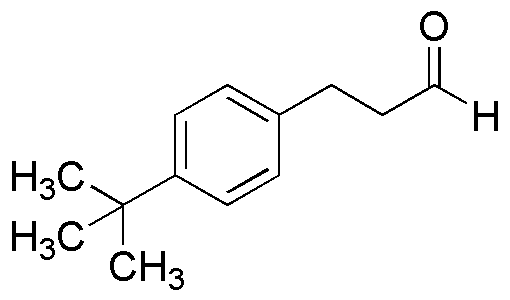3-(4-tert-Butylphenyl)propanal is widely utilized in research focused on:
- Fragrance Industry: This compound serves as a key ingredient in the formulation of perfumes and scented products, providing a unique aromatic profile that enhances consumer appeal.
- Flavoring Agents: It is used in food and beverage applications to impart specific flavors, making it valuable for manufacturers looking to create distinctive taste experiences.
- Pharmaceuticals: The compound is explored for its potential in drug development, particularly in creating intermediates for active pharmaceutical ingredients, which can lead to more effective medications.
- Polymer Production: It acts as a building block in the synthesis of specialty polymers, contributing to materials with enhanced properties for use in various industrial applications.
- Research Applications: In academic and industrial laboratories, it is studied for its chemical reactivity and potential applications in organic synthesis, offering researchers new pathways for innovation.
General Information
Properties
Safety and Regulations
Applications
3-(4-tert-Butylphenyl)propanal is widely utilized in research focused on:
- Fragrance Industry: This compound serves as a key ingredient in the formulation of perfumes and scented products, providing a unique aromatic profile that enhances consumer appeal.
- Flavoring Agents: It is used in food and beverage applications to impart specific flavors, making it valuable for manufacturers looking to create distinctive taste experiences.
- Pharmaceuticals: The compound is explored for its potential in drug development, particularly in creating intermediates for active pharmaceutical ingredients, which can lead to more effective medications.
- Polymer Production: It acts as a building block in the synthesis of specialty polymers, contributing to materials with enhanced properties for use in various industrial applications.
- Research Applications: In academic and industrial laboratories, it is studied for its chemical reactivity and potential applications in organic synthesis, offering researchers new pathways for innovation.
Documents
Safety Data Sheets (SDS)
The SDS provides comprehensive safety information on handling, storage, and disposal of the product.
Product Specification (PS)
The PS provides a comprehensive breakdown of the product’s properties, including chemical composition, physical state, purity, and storage requirements. It also details acceptable quality ranges and the product's intended applications.
Certificates of Analysis (COA)
Search for Certificates of Analysis (COA) by entering the products Lot Number. Lot and Batch Numbers can be found on a product’s label following the words ‘Lot’ or ‘Batch’.
*Catalog Number
*Lot Number
Certificates Of Origin (COO)
This COO confirms the country where the product was manufactured, and also details the materials and components used in it and whether it is derived from natural, synthetic, or other specific sources. This certificate may be required for customs, trade, and regulatory compliance.
*Catalog Number
*Lot Number
Safety Data Sheets (SDS)
The SDS provides comprehensive safety information on handling, storage, and disposal of the product.
DownloadProduct Specification (PS)
The PS provides a comprehensive breakdown of the product’s properties, including chemical composition, physical state, purity, and storage requirements. It also details acceptable quality ranges and the product's intended applications.
DownloadCertificates of Analysis (COA)
Search for Certificates of Analysis (COA) by entering the products Lot Number. Lot and Batch Numbers can be found on a product’s label following the words ‘Lot’ or ‘Batch’.
*Catalog Number
*Lot Number
Certificates Of Origin (COO)
This COO confirms the country where the product was manufactured, and also details the materials and components used in it and whether it is derived from natural, synthetic, or other specific sources. This certificate may be required for customs, trade, and regulatory compliance.


